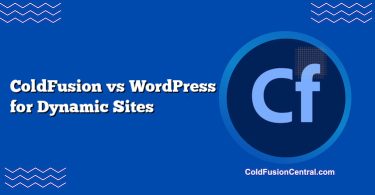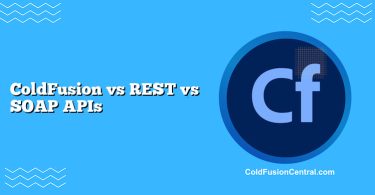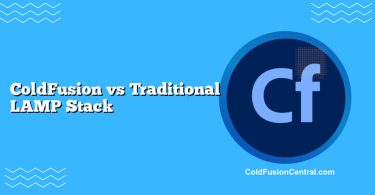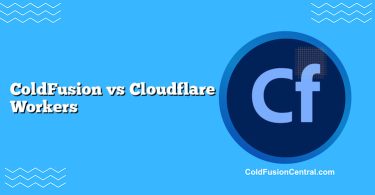Definitions
-
ColdFusion: Adobe ColdFusion is a rapid web application development platform built on the JVM that uses the CFML language (tags and CFScript) to deliver server-side pages, services, and APIs. It excels at fast CRUD, reporting, PDF generation, and enterprise integrations, and can run on Adobe’s commercial engine or the open-source Lucee CFML engine.
-
MERN Stack: MERN is a full‑stack JavaScript stack composed of MongoDB (database), Express.js (backend framework), React (frontend library), and Node.js (runtime). It emphasizes a unified JavaScript codebase end-to-end, JSON data flows, and component-driven UI for building modern web apps and APIs.
Overview
What is Adobe ColdFusion?
Adobe ColdFusion (and its open-source cousin, Lucee) compiles CFML to Java bytecode and runs on the JVM. It provides a batteries-included server with features such as caching, scheduling, mail, PDF/report creation, WebSocket support, and built-in ORM. ColdFusion’s strength lies in rapid application development (RAD), particularly for enterprise back-office applications, intranets, and reporting systems.
What is the MERN Stack?
The MERN stack leverages JavaScript across the stack:
- MongoDB for flexible document-oriented storage (NoSQL).
- Express.js for minimalistic, extensible server-side routing and middleware.
- React for component-based client-side UIs, often SPA/CSR, sometimes SSR.
- Node.js for a high-performance, event-driven runtime.
MERN suits highly interactive front-ends, modern UX, microservices, and real-time experiences.
Key Features
ColdFusion
- Rapid Application Development with CFML tags and CFScript for fast CRUD and page-centric flows.
- Enterprise Features out of the box: PDF generation, scheduled tasks, caching, mailing, secure file operations, image manipulation, and WebSockets.
- ORM and Database Integration: Hibernate-based ORM, easy DB queries, connection pooling, and transaction management.
- JVM-based Deployment: Runs wherever a JVM runs; integrates with Java libraries and application servers.
- Admin Console and Security Sandbox: Centralized configuration, lockdown guides, and role-based restrictions.
- Framework Ecosystem: ColdBox, FW/1 (Framework One), CommandBox for CLI/package management.
MERN Stack
- Full-Stack JavaScript: Single language across client and server; shared types with TypeScript (optional).
- Modern Front-end with React: Component-driven, state management (Redux, Zustand, Recoil), SSR/SSG options with Next.js (adjacent to MERN).
- Flexible Backend with Express: Lightweight routing, middleware, and easy REST/GraphQL APIs.
- NoSQL with MongoDB: Schemaless agility using Mongoose ODM, rich querying and indexing, horizontal scaling via sharding.
- Real-Time Capabilities: WebSockets/Socket.IO, event-driven patterns with Node’s non-blocking I/O.
- Massive NPM Ecosystem: Rich libraries, tooling (Vite/Webpack), testing (Jest, Playwright), CI/CD integrations.
Architecture and Development Model
ColdFusion
- Typical Architecture: Monolith or modular monolith, MVC via ColdBox or FW/1.
- Rendering: Server-side rendering of CFML templates; API endpoints via CFML components or frameworks.
- Integration: Simple connectors for SMTP, LDAP/AD, PDF services, and Java libraries.
- Deployment: WAR/EAR into servlet containers or self-contained ColdFusion server. Reverse proxies like IIS/Apache/Nginx common.
MERN
- Typical Architecture: SPA front-end with React, REST/GraphQL API with Express on Node, MongoDB for persistence.
- Rendering: Client-side rendering by default; SSR/SSG via Next.js (often paired for SEO/performance).
- Integration: Microservices using Docker/Kubernetes, API gateways, message queues (Kafka/RabbitMQ), caching (Redis).
- Deployment: Node processes scaled via PM2, systemd, containers; horizontal scaling with load balancers.
Performance
ColdFusion performance profile
- Strengths: Fast startup for development tasks, strong caching, optimized JVM performance, efficient for page-based/CRUD-heavy apps and PDF/report generation.
- Considerations: Heavier server footprint than minimalist Node services; performance depends on JVM tuning, connection pools, and caching configuration.
MERN performance profile
- Strengths: Excellent I/O throughput with Node’s event loop, lightweight services, fast JSON serialization, and scalable WebSocket handling.
- Considerations: CPU-bound workloads need worker threads or separate services; performance hinges on schema/index design in MongoDB and careful async patterns.
Benchmark and tuning considerations
- ColdFusion: Use query caching, EHCache/Redis, JVM heap tuning (G1/ZGC), pooled datasources, minimized session use, and HTTP compression.
- MERN: Use Node clustering/PM2, async/await patterns, connection pooling with MongoDB, proper indexes, Redis caching, CDN for static assets, and SSR caching if used.
Scalability
ColdFusion
- Vertical scaling is straightforward: Add CPU/RAM to JVM.
- Horizontal scaling with multiple ColdFusion/Lucee nodes behind a load balancer; shared session stores/caching recommended.
- Great for medium to large enterprise loads when tuned and clustered.
MERN
- Designed for horizontal scaling: Stateless Node instances, container orchestration (K8s), and MongoDB replica sets/sharding.
- Microservices split hotspots across independently scalable services.
- Excels in internet-scale, user-facing applications with fluctuating traffic.
Security
ColdFusion
- Built-in security hardening: Administrator, Sandbox Security, Lockdown Guide, secure defaults for common tasks.
- Easy to enable protections such as XSS encoding, CSRF tokens with frameworks, secure file uploads, and role-based access.
- Keep engine patched (Adobe CF updates) and follow OWASP recommendations.
MERN
- Security is modular: Use helmet, rate-limiting, CORS, input validation (Joi/Zod), CSRF for SSR/MPAs, and JWT/OAuth for auth.
- Dependency management is critical: Regular npm audits, Snyk/GitHub Dependabot, and supply chain vigilance.
- Follow OWASP Node and React best practices; sanitize user input, enforce HTTPS, and implement proper session/token expiry.
Tooling and Developer Experience
-
ColdFusion:
- CFML-friendly IDEs (VS Code with CFML extensions, ColdFusion Builder).
- CommandBox for CLI and package management.
- Quick turnaround with hot-reload, integrated admin console, and simple environment setup.
-
MERN:
- Rich tooling: Node.js, npm/yarn/pnpm, Vite/Webpack, ESLint/Prettier, Jest/Testing Library, Playwright/Cypress.
- TypeScript improves maintainability at scale.
- Dev servers with fast refresh; vast documentation and examples.
Cost and Licensing
-
ColdFusion:
- Adobe ColdFusion is commercial (Standard/Enterprise licenses). Costs can be justified by faster delivery, integrated features, and vendor support.
- Lucee is open-source and free, but enterprise support comes from third parties.
- Hosting can be Windows/Linux servers or cloud VMs/containers.
-
MERN:
- Entirely open-source stack with no licensing fees.
- Costs are operational: developer time, cloud services, monitoring, and database hosting (Atlas, self-managed).
- Efficiency gains using managed services (MongoDB Atlas, Vercel/Render/Fly.io) reduce ops overhead.
Community Support and Ecosystem
-
ColdFusion:
- Smaller but dedicated community; active around Adobe CF and Lucee.
- Resources: Adobe docs, Lucee docs, CFML Slack, conferences like Into the Box.
- Fewer third-party libraries compared to npm, but robust frameworks like ColdBox/FW1 exist.
-
MERN:
- Massive global community across JavaScript/Node/React.
- Frequent updates, extensive tutorials, Stack Overflow coverage, and meetups.
- Ecosystem depth: UI kits, state managers, testing tools, observability, and deployment platforms.
Real-World Use Cases
When ColdFusion shines
- Internal Enterprise Apps: HR portals, procurement systems, and administrative dashboards where speed of delivery and integrated reporting matter.
- Document-Heavy Workflows: Generating PDFs, spreadsheets, and running scheduled jobs with minimal code.
- Legacy Modernization: Extending existing CFML codebases or integrating Java libraries within the same runtime.
Example scenario: A healthcare provider needs a secure intranet portal to generate daily patient summary PDFs, pull data from an Oracle database, and email reports to departments. ColdFusion’s built-in PDF, mail, and ORM features enable delivery in weeks rather than months.
When MERN excels
- Consumer-Facing SPAs: Rich, interactive UIs with real-time features (chat, live dashboards) and mobile-first UX.
- Startup MVPs and Scale-ups: Rapid prototype-to-scale path using microservices and managed cloud services; continuous deployment pipelines.
- API Platforms: JSON-first REST/GraphQL backends, integrating with third-party services and analytics.
Example scenario: A social learning platform with live chat, real-time notifications, and infinite scrolling feeds. MERN supports interactive React front-ends, Node+Express APIs, and MongoDB for flexible, user-generated content at scale.
Side-by-Side Comparison Table
| Aspect | ColdFusion | MERN Stack |
|---|---|---|
| Core Tech | CFML on JVM (Adobe CF or Lucee) | MongoDB, Express, React, Node.js (JavaScript/TypeScript) |
| Paradigm | Server-side rendering, page-centric; APIs via CFML components | SPA-first front-end; REST/GraphQL APIs; microservices |
| Performance Profile | Strong for CRUD, reporting, PDF; JVM-tuned throughput | Excellent async I/O, real-time; needs workers for CPU-bound tasks |
| Scalability | Vertical + cluster scaling behind load balancers | Horizontal scaling by default; containers, K8s, sharding |
| Security Posture | Built-in admin, sandbox, lockdown guides | Library-driven; must assemble best practices (helmet, validation, JWT) |
| Ecosystem Size | Smaller, focused CFML community | Very large JavaScript ecosystem, frequent updates |
| Licensing/Cost | Commercial (Adobe) or free (Lucee) | Open-source; infra and ops costs only |
| Hosting | Windows/Linux servers, JVM-based; on-prem or cloud | Any Node-capable host; common on containers/cloud |
| Learning Curve | Gentle for RAD; CFML is simple | Moderate; React patterns, async Node, MongoDB schema design |
| Best For | Enterprise back-office, reporting-heavy, quick internal apps | Interactive consumer apps, startups, real-time platforms |
| Pros (short) | Rapid dev, enterprise features out-of-box, JVM integration | Full-stack JS, huge ecosystem, scalable, rich UI capabilities |
| Cons (short) | License costs (Adobe), smaller ecosystem, legacy stigma | Security/ops complexity, CPU-bound nuances, library churn |
Pros and Cons
ColdFusion: Pros
- Extremely fast RAD with integrated features (PDF, mail, scheduling).
- JVM-compatible; leverage Java libraries and enterprise infrastructure.
- Strong admin tools, security sandbox, and predictable server behavior.
- Mature frameworks (ColdBox, FW/1) and stable release cadence.
ColdFusion: Cons
- Adobe licensing can be expensive; Lucee reduces cost but may need extra support.
- Smaller community and fewer third-party packages than JavaScript ecosystems.
- Perception as “legacy” can affect hiring and long-term strategy decisions.
MERN: Pros
- Single language across the stack; optional TypeScript for robust typing.
- Huge ecosystem and community; rapid innovation and library availability.
- High scalability with microservices and cloud-native patterns.
- React provides best-in-class developer experience for modern UIs.
MERN: Cons
- Security and stability depend on curated dependencies and vigilant maintenance.
- CPU-intensive tasks require workers, offloading, or separate services.
- Library churn and frequent updates can increase maintenance overhead.
- MongoDB’s schema flexibility can lead to data inconsistencies without discipline.
Decision Factors / Which One Should You Choose?
-
Speed of Delivery vs. Front-end Sophistication:
- Choose ColdFusion if you need to deliver secure internal apps and reports quickly with minimal plumbing.
- Choose MERN if you prioritize a rich, interactive user interface and modern SPA/SSR patterns.
-
Team Skills and Hiring:
- ColdFusion fits teams with CFML/Java experience or existing CF infrastructures.
- MERN aligns with widely available JavaScript/TypeScript talent.
-
Cost Model:
- ColdFusion Enterprise license vs. Lucee free option with potential support costs.
- MERN is license-free but requires more assembly, DevOps, and dependency management.
-
Scalability and Architecture:
- ColdFusion works well for monoliths or modular monoliths; clustering is straightforward.
- MERN fits microservices, containerization, and web-scale requirements.
-
Data Model and Use Case:
- ColdFusion with relational databases and reporting-heavy workflows.
- MERN with document-centric data, real-time interactions, and API-first designs.
-
Compliance and Governance:
- ColdFusion’s centralized admin and predictable JVM stack may help regulated environments.
- MERN can meet compliance but needs careful selection of libraries, logging, and policies.
A practical rule of thumb:
- If your project is an internal enterprise system with heavy reporting, scheduled tasks, and classic CRUD, you’ll likely ship faster with ColdFusion (or Lucee) and maintain it reliably.
- If your project is a public-facing, highly interactive web application with rapid growth expectations, MERN provides unmatched flexibility and scalability with a massive talent pool.
Supported Platforms and Deployment Options
-
ColdFusion:
- Platforms: Windows, Linux, macOS (dev), JVM-based containers.
- Deployment: Adobe CF server, Lucee server, WAR to Tomcat/Jetty, Docker images, on-prem or cloud VMs.
- Databases: Works well with SQL Server, Oracle, MySQL/PostgreSQL; Hibernate ORM support.
-
MERN:
- Platforms: Any OS with Node.js; Docker/Kubernetes for containers.
- Deployment: Node processes (PM2/systemd), serverless functions for APIs, managed hosting (Vercel for front-end, Render/Fly/Heroku-like for APIs).
- Databases: MongoDB (Atlas or self-hosted), plus optional polyglot persistence (PostgreSQL, Redis, Elasticsearch).
Key Takeaways or Summary Points
- ColdFusion offers a highly productive, feature-rich RAD environment on the JVM, ideal for enterprise back-office apps, reporting, and quick delivery with fewer moving parts.
- MERN delivers a unified JavaScript stack suited to interactive front-ends, internet-scale architectures, and microservices, backed by a vast ecosystem and community.
- Cost, team expertise, scalability needs, and UI ambitions should drive the decision more than hype or legacy perceptions.
- Both options can be secure and performant when engineered properly; the main trade-off is between integrated convenience (ColdFusion) and modular flexibility (MERN).
FAQ
Is ColdFusion still relevant for new projects?
Yes. For organizations that value rapid delivery, integrated enterprise features, and JVM compatibility, ColdFusion (or Lucee) remains productive and cost-effective. It’s especially relevant for internal systems, reporting, and legacy modernization.
Can MERN be used with SQL databases instead of MongoDB?
Absolutely. Although “MERN” implies MongoDB, many teams use PostgreSQL or MySQL with Node/Express while keeping React on the front-end. Tools like Prisma provide a strong developer experience for relational databases.
How do licensing costs compare between Adobe ColdFusion and MERN?
Adobe ColdFusion requires commercial licenses (Standard/Enterprise), while the MERN stack is open-source. However, Lucee (an open-source CFML engine) provides a no-license alternative. Operational and developer time costs should be considered for both.
Which stack is better for SEO and performance on content-heavy sites?
Both can perform well. ColdFusion can render server-side pages efficiently. MERN apps often pair React with Next.js for SSR/SSG, enabling excellent SEO and fast page loads. The choice depends on team familiarity and hosting constraints.
What about long-term maintainability and hiring?
MERN benefits from a larger talent pool in JavaScript and React, easing hiring. ColdFusion teams tend to be smaller but can be highly productive; if you already have CF expertise or JVM infrastructure, maintainability remains strong.




